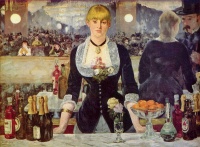Mirror
From The Art and Popular Culture Encyclopedia
| Revision as of 17:47, 20 May 2008 Jahsonic (Talk | contribs) ← Previous diff |
Revision as of 22:45, 24 December 2009 Jahsonic (Talk | contribs) Next diff → |
||
| Line 1: | Line 1: | ||
| [[Image:A Bar at the Folies-Bergère.jpg|thumb|200px|right|''[[A Bar at the Folies-Bergère]]'', painted and exhibited at the [[Paris Salon]] in [[1882]], was the last major work by French painter [[Édouard Manet]] before he died. It depicts a scene in the [[Folies Bergère]] [[nightclub]] in [[Paris]], depicting a [[bar]]-[[girl]], one of the [[demimondaine]], standing before a [[mirror]].]] | [[Image:A Bar at the Folies-Bergère.jpg|thumb|200px|right|''[[A Bar at the Folies-Bergère]]'', painted and exhibited at the [[Paris Salon]] in [[1882]], was the last major work by French painter [[Édouard Manet]] before he died. It depicts a scene in the [[Folies Bergère]] [[nightclub]] in [[Paris]], depicting a [[bar]]-[[girl]], one of the [[demimondaine]], standing before a [[mirror]].]] | ||
| + | [[Image:Rokeby Venus.jpg |thumb|right|200px|''[[Rokeby Venus]]'' (c. [[1649]]) by [[Diego Velázquez]]]] | ||
| {{Template}} | {{Template}} | ||
| # A smooth surface, usually made of [[glass]] with [[reflective]] material painted on the underside, that reflects light so as to give an [[image]] of what is in front of it. | # A smooth surface, usually made of [[glass]] with [[reflective]] material painted on the underside, that reflects light so as to give an [[image]] of what is in front of it. | ||
Revision as of 22:45, 24 December 2009

|
Related e |
|
Featured: |
- A smooth surface, usually made of glass with reflective material painted on the underside, that reflects light so as to give an image of what is in front of it.
- figurative an object, person, or event that reflects or gives a picture of another.
Mirror in Art
Filippo Brunelleschi discovered the linear perspective with the help of the mirror, Leonardo called the mirror the "master of painters". He recommended. "When you wish to see whether your whole picture accords with what you have portrayed from nature take a mirror and reflect the actual object in it. Compare what is reflected with your painting and carefully consider whether both likenesses of the subject correspond, particularly in regard to the mirror. The mirror is the central device in some of the greatest of European paintings: Jan Van Eyck's Marriage of Arnolfini, Diego Velazquez's Las Meninas and Edouard Manet’s A Bar at the Folies-Bergère. Without a mirror, the great self portraits by Dürer, Rembrandt, Van Gogh and Frida Kahlo could not have been painted. M.C. Escher used special shape of mirrors in order to have a much more complete view of the surroundings than by direct observation (Hand with Reflecting Sphere). István Orosz’s anamorphic works are images distorted such way that they only become clearly visible when reflected in a suitably-shaped and positioned mirror. Some other contemporary artists use mirrors as the material of art, like in mirror-sculptures and paintings on mirror surfaces.
Mirror in Literature

